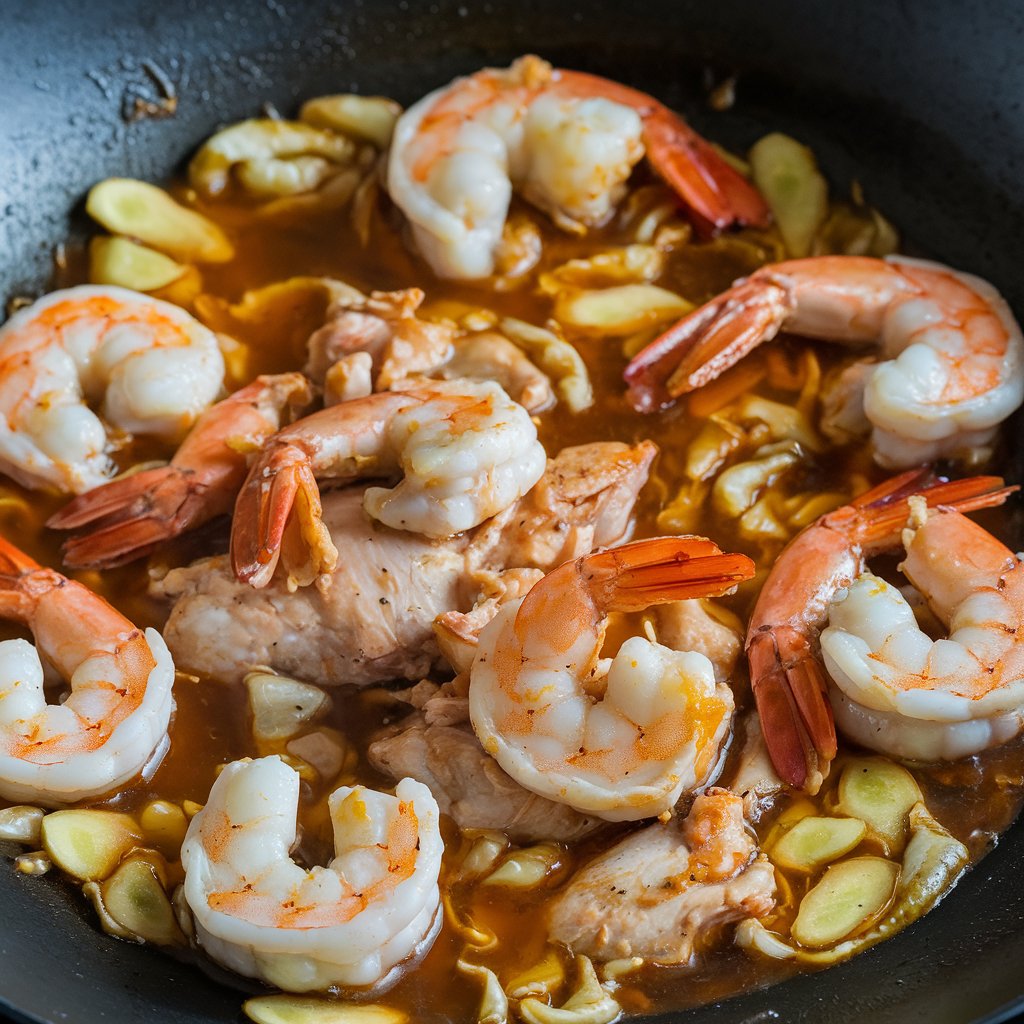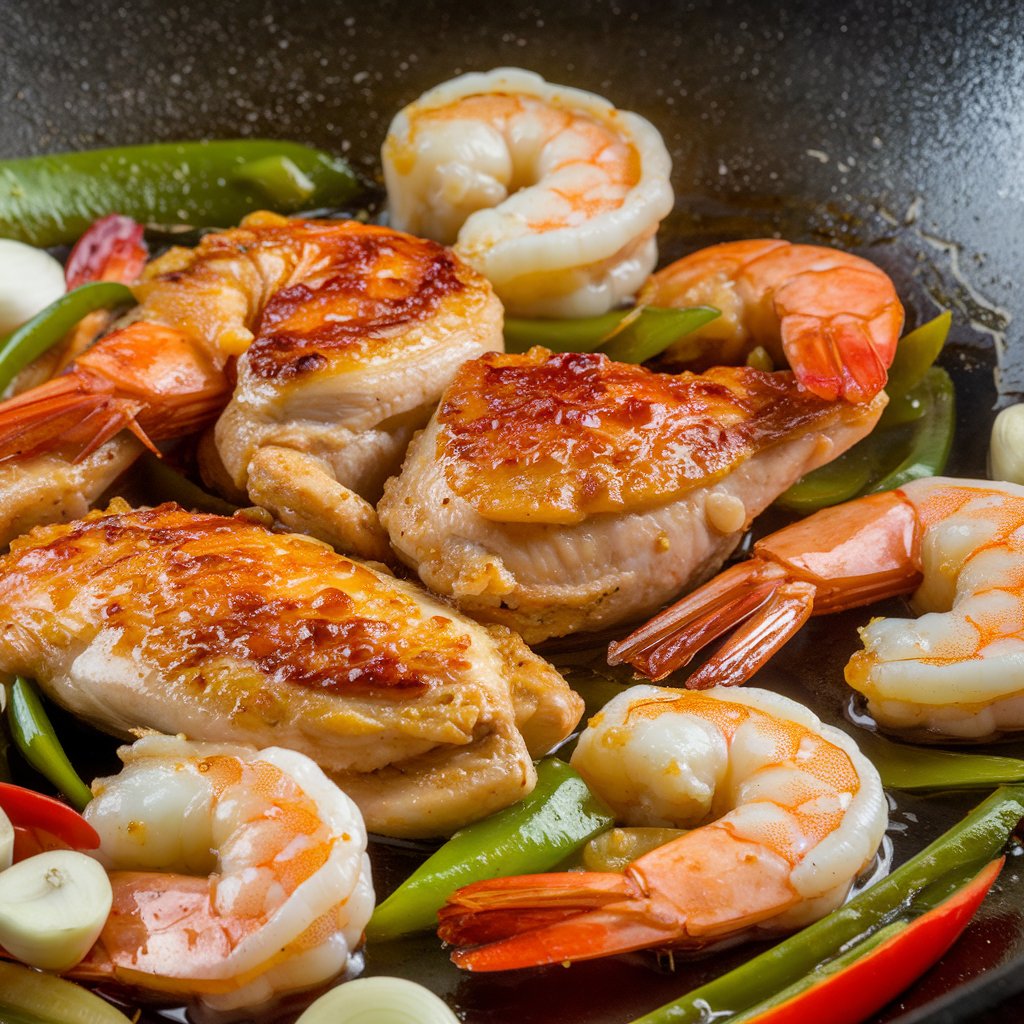Introduction
When you think of quick, delicious, and nutritious meals, chicken and shrimp stir fry likely comes to mind. It’s the perfect marriage of tender chicken, succulent shrimp, and vibrant vegetables, all brought together with a savory sauce. 🥢
But what makes this dish so irresistible? Well, it’s a combination of its versatility, simplicity, and the balance it offers between flavor and health. Whether you’re an experienced cook or a beginner in the kitchen, this guide will help you create a stir fry so good, you’ll ditch the takeout menu for good. Let’s dive in! 🚀
Table of Contents
Ingredients for Chicken and Shrimp Stir Fry
Creating a mouthwatering chicken and shrimp stir fry starts with selecting the right ingredients. Each component contributes to the dish’s overall flavor, texture, and nutritional value. Let’s break down the essentials.
Essential Proteins: Chicken and Shrimp
The stars of this dish are, of course, the chicken and shrimp. Here’s how to choose the best options:
- Chicken: Boneless, skinless chicken breasts or thighs are ideal. Breasts offer a leaner option, while thighs are juicier and more forgiving if slightly overcooked.
- Shrimp: Opt for medium to large shrimp that are deveined and peeled for convenience. Fresh shrimp work best, but frozen shrimp are an excellent alternative when fresh isn’t available.
💡 Pro Tip: Marinate the chicken and shrimp separately to maximize their unique flavors. Use soy sauce, garlic, and a touch of sesame oil for a rich, savory base.
Vibrant Vegetables to Include
One of the joys of stir-frying is the array of vegetables you can include. Here are some popular choices:
- Bell Peppers: Red, yellow, and green peppers add sweetness and a pop of color.
- Broccoli: A crunchy addition that pairs well with the proteins.
- Carrots: Julienne or thinly slice them for a subtle sweetness.
- Snow Peas: Add a fresh, crisp element.
- Onions: Enhance the dish with their natural sweetness when caramelized.
🥦 Fun Fact: Adding a rainbow of vegetables not only looks appetizing but also ensures a variety of vitamins and minerals!
The Importance of Sauces and Spices
The sauce is the soul of any stir fry. For this dish, aim for a balance of salty, sweet, tangy, and umami flavors. Key ingredients include:
- Soy Sauce: The foundation of many Asian-inspired sauces.
- Oyster Sauce: Adds a deep, savory richness.
- Garlic and Ginger: Bring freshness and spice to the dish.
- Honey or Brown Sugar: Introduces a hint of sweetness.
- Cornstarch: Helps thicken the sauce for a glossy finish.
🌟 Pro Tip: Taste as you go! A well-balanced sauce can make or break your dish.
Step-by-Step Recipe for Chicken and Shrimp Stir Fry
Now that you have your ingredients ready, it’s time to cook! This section will guide you through the process, ensuring every step is seamless and enjoyable.
Preparing Your Ingredients
- Slice the Chicken: Cut it into bite-sized pieces for even cooking.
- Marinate the Proteins: Use separate bowls to marinate the chicken and shrimp for at least 15 minutes.
- Chop Vegetables: Uniformly slice vegetables to ensure they cook evenly.
- Mix the Sauce: Combine soy sauce, oyster sauce, minced garlic, grated ginger, and a touch of sugar in a small bowl.
💡 Chef’s Tip: Have all your ingredients prepped and ready before you start cooking. Stir-frying is a fast process, so there’s no time to chop mid-cook.

Cooking Chicken and Shrimp to Perfection
- Heat Your Pan: Use a wok or a large skillet over high heat. Add a splash of oil.
- Cook the Chicken: Stir-fry until it’s golden and cooked through, then set it aside.
- Sear the Shrimp: Quickly cook the shrimp until they turn pink. Overcooking will make them rubbery, so watch closely.
🔥 Hot Tip: Cook proteins in batches to avoid overcrowding, which can make them steam instead of sear.
Stir-Frying Techniques for a Delicious Outcome
- Start with Aromatics: Add garlic and ginger to the hot pan for a fragrant base.
- Add Vegetables: Stir-fry in the order of their cooking time, starting with harder veggies like carrots and broccoli.
- Combine Everything: Return the chicken and shrimp to the pan, pouring the sauce over the top. Stir until everything is coated and heated through.
🎉 Success Secret: Keep the heat high and stir continuously to achieve that signature stir-fry texture and flavor.
Mixing the Perfect Sauce
Once the sauce is added, allow it to simmer briefly. The cornstarch will thicken it, creating a silky coating over the chicken, shrimp, and vegetables. If needed, adjust the seasoning with extra soy sauce or a dash of lime juice for brightness.
Common Mistakes and How to Avoid Them
Even the most experienced cooks can stumble when making a stir fry. Let’s look at the common pitfalls and how to sidestep them to create a flawless chicken and shrimp stir fry every time.
Overcooking Proteins
Overcooked chicken becomes dry, and shrimp turns rubbery. Avoid this by:
- Timing Your Cook: Chicken typically needs 5–7 minutes, while shrimp cooks in just 2–3 minutes.
- Cooking in Batches: This ensures even cooking without overcrowding the pan.
- Using Residual Heat: Proteins continue cooking slightly after being removed from the heat, so take them off just before they’re fully done.
💬 Quote: “Cooking is all about timing, especially when it comes to delicate proteins like shrimp!”
Using Too Much Oil
It’s easy to over-pour oil when stir-frying, which can make the dish greasy and heavy. Here’s how to avoid it:
- Preheat Your Pan: A hot pan requires less oil to prevent sticking.
- Use a Measuring Spoon: Stick to 1–2 tablespoons of oil for most stir-fries.
- Opt for Neutral Oils: Oils like canola, vegetable, or avocado are ideal for high-heat cooking.
🔥 Tip: If your dish looks oily, blot excess oil with a paper towel before serving.
Balancing Flavors Effectively
A great stir fry strikes a harmony between salty, sweet, tangy, and umami flavors. To achieve this:
- Taste Frequently: Adjust seasoning as you go—don’t wait until the end.
- Balance Sweetness and Saltiness: Add sugar or honey sparingly, and balance it with soy sauce or a splash of vinegar.
- Add Acidity Last: A squeeze of lemon or lime at the end brightens the dish without overpowering it.
💡 Pro Tip: If your stir fry tastes flat, a teaspoon of fish sauce or a pinch of chili flakes can work wonders.
Health Benefits of Chicken and Shrimp Stir Fry
Beyond its delicious taste, chicken and shrimp stir fry is packed with health benefits, making it a smart choice for any meal.
High in Protein and Nutrients
Both chicken and shrimp are excellent sources of lean protein, crucial for muscle growth and repair. Add the array of vegetables, and you’ve got a meal rich in:
- Vitamins: Bell peppers and broccoli bring vitamins A, C, and K to the table.
- Minerals: Shrimp provides selenium and zinc, while chicken adds iron.
- Fiber: Vegetables like carrots and snow peas contribute dietary fiber for better digestion.
🦐 Fun Fact: A serving of shrimp contains 20 grams of protein and only 85 calories!
A Low-Calorie, Balanced Meal
Stir fry is an excellent option for those watching their calorie intake. By steaming or lightly stir-frying vegetables and using minimal oil, you keep the dish light without sacrificing flavor. Plus:
- Low in Carbs: Swap rice or noodles for zucchini noodles or cauliflower rice for a keto-friendly version.
- High Satiety: Protein and fiber help keep you full longer, reducing snacking.
The Role of Fresh Ingredients in Health
Fresh vegetables not only taste better but also retain more nutrients compared to frozen or canned options. They’re:
- Rich in Antioxidants: Protecting your body against inflammation.
- Naturally Low in Sodium: Unlike many prepackaged stir fry mixes.
🌟 Pro Tip: Shop seasonal produce for the best flavor and nutritional content.
Variations of Chicken and Shrimp Stir Fry
Stir fry is a canvas for culinary creativity. Here are some popular variations to suit different tastes and dietary needs.
Keto-Friendly Stir Fry
Looking for a low-carb option? Make these swaps:
- Zucchini or Shirataki Noodles: Replace traditional noodles.
- Coconut Aminos: Use this instead of soy sauce for a lower-sodium alternative.
- Extra Fats: Toss in avocado oil or sprinkle with sesame seeds for added healthy fats.
Vegan and Vegetarian Alternatives
While chicken and shrimp are the main attractions, you can easily adapt this dish for a plant-based diet:
- Replace Proteins: Use tofu, tempeh, or edamame.
- Boost Flavor: Add mushrooms for an umami punch.
- Swap Sauce Ingredients: Replace oyster sauce with mushroom sauce for a vegan-friendly alternative.
🍄 Fun Fact: Tofu absorbs stir-fry sauces like a sponge, making it an excellent meat substitute.
Regional Flavors and Additions
Take your stir fry around the world by incorporating regional ingredients:
- Thai Style: Add Thai basil, fish sauce, and a splash of lime.
- Chinese Style: Use hoisin sauce, sesame oil, and green onions.
- Japanese Style: Include mirin, sake, and a sprinkle of toasted sesame seeds.
🌏 Creative Tip: Pair your stir fry with rice or noodles that complement the regional flavor you’re emulating.
Frequently Asked Questions (FAQs)
To ensure your chicken and shrimp stir fry turns out perfectly, here are answers to some common questions that might pop up while preparing this dish.
Can I Use Frozen Ingredients?
Absolutely! Frozen chicken, shrimp, and vegetables can be great time-savers. However, there are a few tips to follow:
- Thaw Properly: Allow frozen ingredients to thaw in the refrigerator overnight or under cold running water.
- Pat Dry: Ensure they’re dry before cooking to avoid excess moisture, which can make the stir fry soggy.
- Cook Thoroughly: Adjust cooking times slightly, as frozen ingredients may take longer to heat through.
💬 Quote: “Frozen veggies are like a safety net for busy days—they’re ready when you are!”
What’s the Best Oil for Stir-Frying?
The oil you choose can make a big difference in flavor and cooking results. For the best outcome:
- Neutral Oils: Canola, vegetable, or grapeseed oil are excellent for high-heat cooking.
- Flavorful Options: Peanut oil adds a nutty aroma, while sesame oil is ideal for finishing touches, not primary cooking.
🔥 Pro Tip: Avoid olive oil—it has a lower smoke point and can burn easily during stir-frying.
How Do I Store Leftovers?
Stir fry leftovers make a quick and easy meal for the next day. To store properly:
- Cool Down Quickly: Let the dish cool completely before transferring it to an airtight container.
- Refrigerate: Store in the fridge for up to 3–4 days.
- Reheat Gently: Use a skillet or microwave, adding a splash of water or sauce to prevent dryness.
💡 Chef’s Tip: Avoid freezing stir fry with vegetables, as they can become mushy when reheated.
What Can I Serve with Chicken and Shrimp Stir Fry?
Stir fry is versatile and pairs well with various sides, including:
- Steamed Rice: Jasmine or basmati rice absorbs the flavorful sauce perfectly.
- Noodles: Lo mein or soba noodles create a hearty meal.
- Low-Carb Options: Cauliflower rice or zucchini noodles for lighter alternatives.
🍚 Fun Fact: In Asian cuisine, rice isn’t just a side—it’s a symbol of prosperity and unity.
Conclusion
Chicken and shrimp stir fry is a true culinary gem—delicious, quick, and endlessly adaptable. By mastering the techniques and understanding the nuances of each ingredient, you can create a dish that satisfies both your taste buds and your nutritional needs. Whether you’re cooking for a family dinner, meal prepping for the week, or impressing guests, this dish is a guaranteed hit.
So, what are you waiting for? Grab your wok, fire up the stove, and stir-fry your way to a delightful meal! 🥢✨

